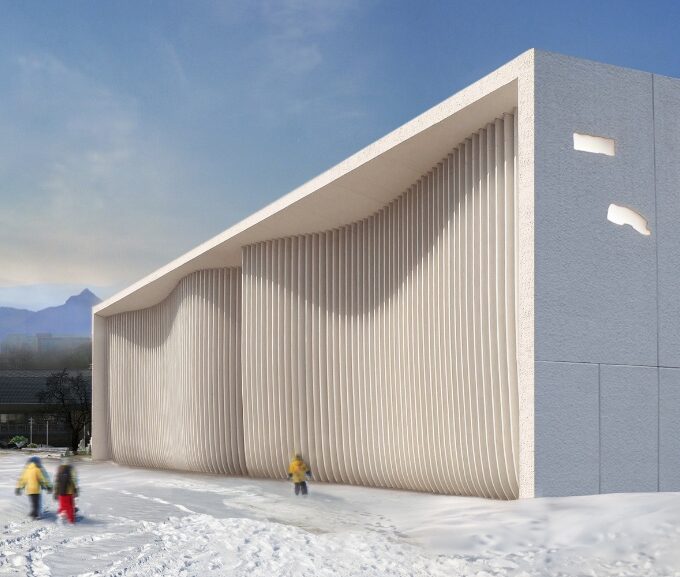With tons of options on the market, it can be difficult to find the metal roof suited for your home. You have to consider the environment you live in and the aesthetic appeal you want when choosing a panel profile. One of the most popular roofing options are Standing Seam roofs.
What is a Standing Seam Metal Roof?
Standing Seam can be defined as a seam made by turning up two adjacent edges and folding the upstanding parts over on themselves, therefore creating a seamless look. Standing Seam metal roofing systems use hidden fasteners, meaning the hardware used to secure the panels to the substrate are hidden beneath the panels instead of exposed on top of them. Typically, standing seam panels are completely flat or striated, with the ridges or bumps being at the seams (or vertical legs). They use a raised, interlocking seam to join one panel to another, allowing for crisp, clean lines.
Benefits of Standing Seam Metal Roofing
Compared to other panel profiles, a standing seam metal roof has quite a few benefits. Here are just a few:
- Aesthetics: The sleek lines and crisp, seamless look of the panels make them highly attractive to anyone looking for high-end or modern looking finished roof.
- High-Performance: Standing Seam panels are typically tested heavily against extreme weather conditions, like high-speed winds or heavy hail, and come out performing wonderfully.
- Fastener System: The hidden fastener system used in Standing Seam metal roofing eliminates most issues related to faulty, improperly installed, or rusting fasteners, which can occur with exposed fastener systems.
- Longevity: Like the majority of metal roofing options, Standing Seam roofs have an average lifetime of 40-70 years, compared to other materials like shingles, which typically only last between 10-20 years.
- Durability: Just like other metal roofs, Standing Seam’s durability is a huge advantage — it stands up extremely well in all different types of environments with ease.
Types of Standing Seam Panel
3″ Trapezoidal — This panel is designed for large-scale applications, including both industrial and commercials buildings. It works well for long spans and low-sloped roofs, and is available in 16”, 18”, and 24” widths.
2″ Mechanical Lock — The 2” Mechanical Lock panel is ideal for low-sloped and wide span roofs. It’s a commercial-grade panel that’s mechanically seamed and is perfect for open purlin systems. This panel can also be radiused into architectural curves — great for curved roofs, arced accents, and statement-making details.
Mechanical Lock — Available in 1” and 1.5” rib heights, this panel creates a seamless looking roof. The Mechanical Lock panel’s adaptability makes it a favorite in all different types of environments and for both residential and commercial roofing needs.

Tru Snap —Tru Snap panel systems work well in both residential and commercial builds. Their ability to be used on low-slopes, create crisp, clean lines, and the wide range of rib heights makes them a favorite. There are custom lengths available, so they’re able to be adapted to fit into any environment.

Nail Strip — With easy installation, the Nail Strip panel system is a favorite among DIYers. It’s available in two different rib heights and is an extremely versatile and durable roofing option.

What’s the Difference Between Each Type of Standing Seam Panel?
Each Standing Seam panel is installed and secured to the roof’s substrate differently. Their names each reflect the different ways they come together.
Mechanical Lock panels are mechanically fastened to one another, meaning a special tool called a seamer is needed to “lock” them together. These panels use a clipped system that fastens them to the substrate. Then, you use an electric or hand seamer to press them together mechanically, which bends each panel over one another and creates a lip. Mechanical Lock panels require a more advanced installation.
Tru Snap metal panels have two identical female legs and “snap” together. With Tru Snap, the male leg is clipped, and that clip is fastened directly to the decking. These panels require more parts and pieces, making installation a bit more difficult. However, Tru Snap can be run with longer panels due to the clipped system it uses, which allows the panels to move more freely through expansion and contraction.
Nail Strip metal panels also have two identical female legs. The big difference is that with Nail Strip panels, the male leg has a perforated nail flange used to fasten the panel directly to the decking. Nail Strip is a bit easier and more straightforward when it comes to installation, however it is limited by how long you can run the panels since they’re screwed directly to the decking.
FAQs About Standing Seam Roofs
When you’re considering installing a Standing Seam metal roof, you may have a few questions. Here are some of the most frequently asked questions about these roofing systems:
1. How much do Standing Seam metal roofs cost?
Compared to other panels like Corrugated or Multi-Purpose, Standing Seam panels are a bit pricier. Price point depends heavily on the specifications of your project, including how much material you need, the desired gauge/thickness, whether or not you need customization, and the color or finish you choose. Price can also be impacted by installation — typically a DIY install reduces the costs. Most homeowners choose to install a standing seam roof due to its appearance and longevity, making it worth the investment for most.
2. Are Standing Seam roofs difficult to install myself?
Due to their clip and fastener systems, Standing Seam roofs can be a little more difficult to install compared to metal roofing panels that use exposed fasteners. Installing a Standing Seam roof requires some specialty tools and some experience with installing metal roofs. You should talk to a Product Specialist before installing so you can ensure you have the right tools and latest installation guide.
3. Can I add striations to the panels?
It’s advisable to add striations to Standing Seam metal roofs to reduce oil canning. Oil canning commonly occurs in flat metal roofing applications, like Standing Seam, which is a visible distortion of the panel. This is usually caused by improper installation or the metal panels expanding and contacting with changing temperatures. Adding striations, which are a series of ridges or waves, helps reduce this issue.
4. What clips are used with these panels and how to attach them?
A Standing Seam metal roof has three different clip systems: fixed, slider, and floating. Each clip system has their own unique differences. You can read about this in our previous post Comparing Clip Systems for Metal Roofing: Fixed, Slider, and Floating.
5. What are the different gauges can I order with them?
Gauge refers to the metal panel’s thickness. Each Standing Seam panel profile can be ordered in the following gauges:
3″ Trapezoidal — 22 and 24 Gauge
2″ Mechanical Lock — 22, 24, and 26 Gauge
Mechanical Lock — 22, 24, and 26 Gauge
Tru Snap — 22, 24, and 26 (1” & 1.75”) Gauge
Nail Strip — 24 and 26 Gauge
6. Is it possible to run these panels on my site?
Due to their manufacturing process, most Standing Seam panels can be created at the job site. This reduces turnaround time and allows for longer panels to be created and an even more seamless look to be achieved. Running the panels on site also reduces any potential damages or risks from shipping and delivering.












